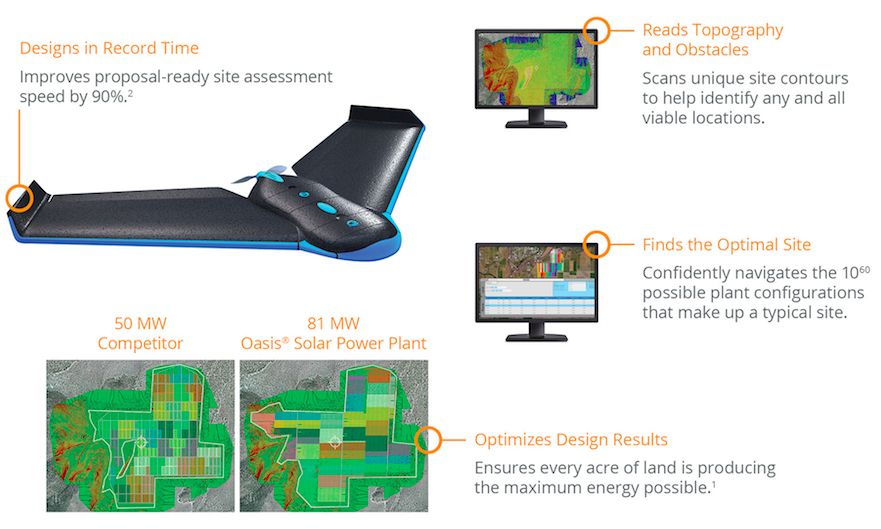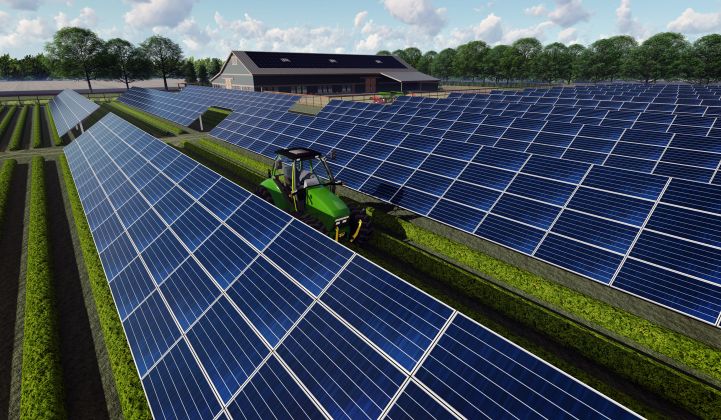It’s a new era for the solar industry. Today, technology innovation extends well beyond the solar panel to the entire system, which companies like SunPower believe is key to helping solar become a leading energy source.
Last week, SunPower launched its third-generation Oasis platform for large-scale solar projects at the company’s new research and development facility in Davis, California. The latest iteration features advanced design tools, drones, robots and new agriculture practices that aim to improve project performance from site development through to operations and maintenance.
“Right now, as we’re seeing [power-purchase agreement] rates fall, we really need to look at every detail in the system and find a way to optimize everything,” said Matt Campbell, vice president of power plant products for SunPower.
More than 700 megawatts' worth of new Oasis platform projects have already been awarded, with construction starting in North America and China within the coming weeks. In 2017, all new SunPower solar plants will be built using the third-generation Oasis platform.
“SunPower Oasis allows customers to generate more value from a broader selection of potential power-plant sites, at an accelerated pace,” said Tom Werner, SunPower president and CEO. “An Oasis solar power plant may be designed 90 percent faster than the time required to design conventional solar power plants. While flat, rectangular-shaped sites are required for other trackers on the market, Oasis can take advantage of unused, irregularly shaped areas and slopes up to 10 degrees to generate up to 60 percent more energy than conventional technology installed at the same site.”
Each additional 10 acres of usable land on a given project site represents 2 to 4 more megawatts of power, Werner said. Therefore, the ability to maximize the use of a site can significantly impact a project’s bottom line, and help the large-scale solar sector grow as premium space becomes constrained.
Global energy optimization
The next-generation Oasis platform includes SunPower’s new global energy optimization (GEO) system that automates project design using drones and proprietary software, developed with support from the Department of Energy’s SunShot Initiative.
The drone is flown over a potential project site, collects images, and feeds those images into a cloud-based software system that comes up with dozens of site-design options. The platform allows developers to screen a large number of sites quickly, and allows owners to ensure their projects have been optimized to meet their financial and energy targets.
“The drone is really just an imaging tool,” said Campbell. “The key is the software that was developed by SunPower, which takes the images, crosses them in our cloud servers, creates a three-dimensional map, and then the software comes in and proposes hundreds of layouts to optimize for capacity or financial return.”
While the software is the secret sauce, the drones play a pivotal role. Drones not only help with project design, but they can also be used to track site production. Instead of sending expensive project managers out to a site, the drone uses a remote monitoring management tool to track progress and an infrared imaging system to detect any issues. All of that data is fed into the GEO system to ensure project deployment is smooth and speedy.
FIGURE 1: Oasis GEO System

Once built, robots used in the third-generation Oasis platform will be able to clean soiled panels using 75 percent less water than manual cleaning methods and operate at night to avoid interfering with daytime energy production. The robots were initially developed by Greenbotics, which SunPower acquired in 2013, and developed further with SunShot support.
SunPower’s next-generation robotics cleaning technology is expected to be able to clean 10 megawatts' worth of panels in 10 hours with just three workers and a pickup truck. The pace is twice as fast as the company’s current robotic cleaning technology, and 10 times faster than competing manual cleaning methods.
“It may not sound like that big of a deal, but as the cost of solar energy comes down for ground-mounted systems, the percentage of the costs of operations and maintenances goes up,” said Werner. “It can be as high as 15 percent [of the overall system cost], so having robots to clean the system is a huge deal.”
With equipment costs falling and land constraints increasing, innovative solutions are needed to bring the solar sector meaningfully beyond 1 percent of U.S. energy generation.
“A lot of the beginning of the solar industry was focused on the panel,” said Campbell. “Now we're looking at innovation all around the rest of the system. That's why we're always surveying new technology -- whether it's a robot, whether it's a drone, whether it's software -- and saying, ‘How can this help us reduce the cost of solar, build projects faster, and make them more reliable?’”
A redesigned tracker
Another element of SunPower’s new Oasis product is the redesigned tracker system, which will help to overcome concerns about land use.
The next-generation Oasis trackers are unlinked, shorter and wider, which allows for plants to be built on slopes that were previously considered unsuitable for development. SunPower claims its systems can be built on gradients up to 10 degrees, compared to the 6-degree gradient limit for most of its competitors. Shortening the tracker row length from roughly 90 meters to 45 meters also makes the design more compatible with different location types.
Each tracker is now also twice as wide with twice as many panels, which allows a single piece of infrastructure to produce more energy, while reducing the number of parts by roughly half. As part of the new integrated design, there are no combiner boxes, cable trays, motor batteries or other parts that can cause failure. Fewer parts are expected to translate to faster assembly time in the field and cheaper maintenance.
In the past, the two-panel design wasn’t considered viable because wider arrays catch more wind. But SunPower insists wind issues have been completely overcome. “Doubling the number of panels so I can reduce the part count by 50 percent is really hard to do, but that’s what the SunPower design team has done,” said Werner.
FIGURE 2: Simplified Architecture
![]()
In addition, each Oasis tracker row now has an on-board actuator that uses real-time information on voltage and current to inform how the row is controlled, optimizing for performance. This is a departure from previous SunPower products that tracked the sun using GPS. SunPower is not the first company to deploy an unlinked architecture, but it claims to have the first fully integrated design.
“We're taking a holistic view,” said Campbell. “We're the only ones in the world that cover the full spread of the power plant, from finding land through the long-term operation. I think in the future, this integrated approach will provide a lot of value.”
While SunPower's insight into the entire solar value chain is considered to be an advantage, Werner added that the company also plans to forge strategic partnerships to accelerate sales internationally and recover from a poor second-quarter performance. As an example, SunPower plans to leverage its relationship with owner Total to deploy large-scale solar projects in Africa.
"[A company] cannot afford to develop solar projects all over the world, so you have to partner more, and decide where you're going to develop, and where you spend money," said Werner. "I think this is the time for focusing, and also a separation of [where] the strong survive."
Learning how to coexist
Part of taking a holistic view means ensuring that solar power plants don’t conflict with the surrounding area, which is both an economic and environmental concern in many places. To that end, SunPower has partnered with the University of California, Davis to evaluate possible crop varieties that can coexist with large-scale, ground-mounted solar.
The new Oasis design allows for multiple uses because each row is farther apart than in previous designs. And because the trackers are unlinked, there are no obstructions on the ground. In China, SunPower already built a solar farm for Apple that allows yaks to safety graze among the panels. These types of solutions will be needed all around the globe as more solar projects are deployed at gigawatt scale.
“The idea of leveling a field and putting solar panels on it is less and less accepted,” said Werner. “What we would prefer is to take a field and put a solar plant on it and hardly disrupt the field…and we’re getting closer and closer to that.”
The SunPower R&D Ranch -- where the company plans to test a suite of new technologies -- is currently attempting to grow tomatoes and peppers in between the Oasis arrays, but it will attempt to grow other types of crops too. Heiner Lieth, professor at the UC Davis College of Agriculture and Environmental Science, started a solar research project in 2010 and has successfully been able to grow crops in the shade of solar panels. But there’s a lot more work to be done in order to scale these solutions, he said.
“I’m convinced it’s possible,” said Lieth. “The question is what the ideal balances are depending on what you’re going to be using for your cropping systems and what the market is for your electricity and agricultural products. And it opens up a whole world of questions.”
Tomatoes probably aren’t the ideal crop to try to grow right off the bat, he said. Conventional rectangular solar panels probably aren’t the best solution, either. If solar is to become the dominant power source in the U.S. and abroad, it will have to learn how to coexist with agriculture and animals out of pure necessity, Lieth said. And in order to coexist, solar projects will likely need to be designed differently.
“I think it’s a huge opportunity for everybody in the field, and to me, it’s a real surprise nobody has thought outside the box,” Lieth said.



